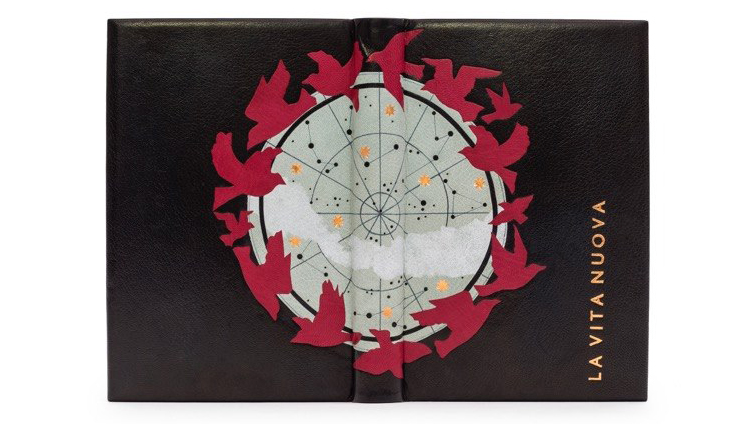Interview with Bec Britain, Winner of the Harmatan Leather Ltd Prize (Designer Bookbinders)
This is the last of the interviews with winners of this year’s Designer Bookbinders awards. Bec Britain has already received Designer Bookbinders prizes a year ago and two years ago. This time she’s got the Harmatan Leather Ltd prize.
Bec works in Brighton, England. Besides bookbinding, she works as an artist, specializing in paper crafts and willow sculpture and in arts project development.
iBookBinding: Both your last year’s 1984 and this year’s La Vita Nuova are examples of the exceptional work with leather. Is that your favorite material or the choice was made only because the books were made for the Designer Bookbinders Competition?
Bec Britain: Thanks! I do have a fondness for leather – it’s such a malleable, tactile material. As these books were made specifically for the DB competition, I’ve focused on leather and trying to hone my skills with it. I have to say I also love wood, metal and plastics – I’m trying to get better with traditional bookbinding materials so I can be more adventurous using other materials in the future.
iBB: Some bookbinders prefer to master only one style (e.g. French binding). However, gallery at your web site suggests that you like to experiment both with style and form. What are your favorite bookbinding styles and techniques?
Bec Britain: While I’m spending a lot of time on fine binding at the moment, I am always interested in new materials and techniques – I really enjoy experimenting. You may have noticed some hardware appearing in 1984 (a spyglass in the front cover) and in Breakfast at Tiffany’s (a pearl necklace wrapped around the book). I like including sculptural elements in my work where the design lends itself to it. I enjoy the challenge of incorporating non-traditional materials into the work without compromising the forwarding.

iBB: What was the trickiest part of the La Vita Nuova binding?
Bec Britain: There were a few…. Managing the scarf joints and inlays over the spine section…. it meant paring three layers of leather pretty thin which makes me nervous. The end papers proved more of a challenge than I anticipated – the combination of paper and foil I was using just weren’t working. I made many versions of the image that were really patchy before finally getting the bronze cross evenly printed. The final challenge was really an exercise in holding my nerve – the fine lines of the celestial map were drawn on when the book was complete and making fine, straight lines around the spine required a very steady hand.
iBB: I love to check different small elements of books. Unfortunately, the photo from Designer Bookbinders doesn’t allow us to peak under the cover. Are there any secrets hidden there? Special endbands, edge decoration, something else?
Bec Britain: So the book has solid, formed head caps instead of more traditional sewn endbands. It’s a technique I learned from Peter Jones and I really like the clean, modern finish it gives, so it’s become a feature of my fine bindings. The book has black edges, with the head in bronze.
iBB: You have received prizes from Designer Bookbinders three years in a row. Do you plan to continue that sequence? =)
Bec Britain: Gosh, I hope so! Each year my dad has come with me to the awards evening, and he has rather taken to having a day out in London and a nice dinner, so the pressure is on to keep it up…. just want to keep improving really.
iBB: Every competition is a chance to look what your colleagues are doing. Which other contestants’ bindings you liked? Are there any new ideas you’d like to try after the competition?
Bec Britain: It’s always really great to see lots of other bindings – particularly lots of interpretations of the same book. This year I really liked the work made by Theresa Wedermeyer – her marbled paper was a marvel and I loved the perfect rounded edge to her case. I also like Kaori Maki’s book – the double layer onlays were beautiful. I saw a technique I’m definitely going to try – Theresa Wedermeyer used contra sections to increase page flexibility and they looked great.
iBB: If there were one piece of advice you would have to tell to a less experienced bookbinder who wanted to enter a competition like Designer Bookbinders what would it be?
Bec Britain: Don’t wait until you think you’re ready. My first entry was only the second fine binding I’d ever made and I felt like a bit of an imposter in that first year! I’m really glad I did though – what I love about entering the competition is that it makes you raise your game (both in terms of design and making), and that’s a good thing for any aspiring binder. When your work is displayed alongside lots of other versions of the same book, you can see much more clearly, where you need to improve. While that can be a sobering experience, it does push you to perfect your skills and finish.
Read More
- Interview with Piotr Jarosz, Winner of the Ash Rare Books Lettering Award
- Interview with Glenn Malkin, Winner of the Folio Society Prize for the Set Book
- Designer Bookbinders Competition Awards Announced (2016)
- Designer Bookbinders Annual Competition Winners Announced (2015)
Please Support us on Patreon!
 The minimum level of contribution is only $1 per month.
The minimum level of contribution is only $1 per month.
Moreover, starting with the pledge level of $3, you will get a digitized vintage book about bookbinding, book history, or book arts each month from us!
These pledges help iBookBinding to continue its work and bring more information about bookbinding and book arts to you!


